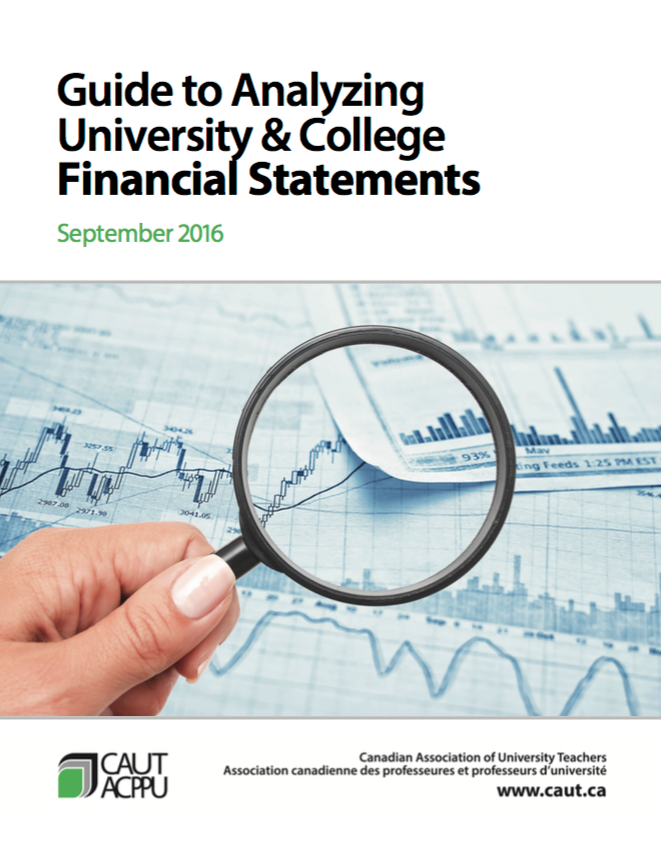The CAUT releases a new guide to help decode university budgets and financial statements
The Canadian Association of University Teachers (CAUT) released a financial guide to facilitate the reading of post-secondary institutions’ financial statements and budgets.
The 27-page guide, which was made available on Sept. 8, was written by University of Manitoba accounting professors Janet and Cameron Morrill. According to the association’s website, the document is a step-by-step guide with the goal to assist academic staff in identifying and understanding the revenues, including types of funding, coming into post-secondary institutions.
The CAUT is a professional association that was formed in 1951 with the purpose of advocating for its members and academic freedom. Today, the association represents 68,000 teachers, researchers, librarians and other academic staff across the country.

David Robinson, CAUT’s director, believes the guide can benefit everyone. “I believe it’s useful for anybody who wants to know what the true financial status of an institution is,” he said in an interview with The Concordian. “So when institutions are saying: ‘We have to raise tuition fees because we’re out of money,’ here’s a way that you can interrogate that. It might be true, it might not be true,” said Robinson.
According to the guide, institutions get their money mainly from provincial governments, tuition fees and private donors. Professors Morrill and Morrill explained their approach to analyzing university and college financial statements is to identify the amounts and origin of the resources available to universities, in order to determine what kind of additional support for academic teaching and research the institutions’ revenues can provide.
Essentially, the guide not only makes reading financial statements easier, but it also ensures that the reader can begin to comprehend universities’ budget-cutting strategies to further analyze or question these strategies.
In a message posted on Concordia’s website on June 29, Concordia President Alan Shepard explained that the university’s revenues from grants and tuitions fees for the 2016-17 year weren’t enough to see a significant lowering of the deficit.
As a strategy to diminish the university’s $6.3 million deficit, this year’s budget included two different Voluntary Retirement Programs—one for full-time faculty, and one for staff members. These buyout programs, whereby professors are offered a certain amount of money to retire early, are a way to reduce university expenses by spending less on tenured, full-time professors.
Academic institutions’ financial statements contain a lot of columns, rows, and most of all, a lot of big numbers. Many of these numbers have been on the rise over the past decade. According to a Canadian Federation of Students statistic cited in a 2015 CBC article, during the 1960s and 1970s, governments covered more than 90 per cent of costs for post-secondary institutions. By 2013, that figure was down to 57 per cent. According to Statistics Canada, public funding is lowering, and therefore, being dramatically replaced by rising tuition fees.
According to Statistics Canada, for the 2014-15 year, total expenditures were approximately $560 million higher than the previous year. Revenues from tuition fees was close to $500 million higher than the previous year. The total revenues of all Canadian colleges and universities for the 2014-15 year were close to $36 billion, a big jump up from $35 billion, the year before. According to Morrill and Morrill, many institutions claim to be in bad financial situations, but the numbers tend to make it seem otherwise.
The numbers are there, the numbers are big, and they can be confusing. What exactly does the “other fees” row in the financial statements refer to? And why is it only ever on the rise, whereas Health Canada revenues and “miscellaneous” revenues fluctuate from year to year? These are the kinds of questions that the guide sets out to answer, or at least, to clarify. “We try to establish whether the institution has unexpended resources that it could use to improve employee compensation and the sustainability of those resources,” explain Morrill and Morrill in the guide.
Concordia’s director of media relations, Chris Mota, says Concordia fully supports this guide, and what it is trying to accomplish. “Financial literacy is something Concordia puts high priority on,” she told The Concordian. Mota said this kind of guide is useful for everyone, but student associations and the student press can especially benefit from it, as they are often faced with the task of dissecting university budgets and numbers. “You can’t be an expert on everything, and universities have their own language,” Mota added.
The CAUT guide, and the questions it sets out to answer, are all part of the larger issue of academic institutions’ spending. While the CAUT guide cannot directly address the larger issue of where money should be going, it can provide information to help answer the crucial questions of where the money is going, and whether or not institutions are hiding anything in their cryptic rows of numbers and monetary amounts.
“It’s important for institutions to be transparent in their financial dealings. We think this [guide] provides an interesting way and a helpful guide to allow [CAUT] members, but also students and the general public, to get a clearer sense of the actual state of the university and college finances,” Robinson said.
Graphic by Thom Bell




